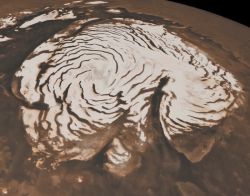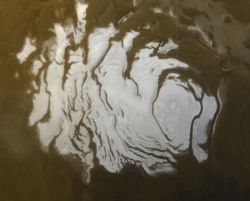![]()
At the north and south poles of Mars lie thick stacks of flat-lying sheets of dust and water ice: the ice caps. These are called Planum Boreum (north) and Planum Australe (south). Both were laid down like pages in a book during countless cycles of climate changes.
Scientists hope to read this book of Mars climate history using the layers. How far back does the record go? The time scale depends on which polar feature you study: some come and go in just a single Mars year (1.9 Earth years), while others have endured for perhaps a billion years.
Ice collects in the polar regions because Mars' rotation axis tilts about 25° to its orbit around the Sun. This gives Mars four distinct seasons, similar to those on Earth. But polar winters on Mars are much colder (–153° Celsius or –243° Fahrenheit) than the coldest winters on Earth.
Mars becomes cold enough for carbon dioxide (CO2) gas to condense directly out of the atmosphere as snow or frost. As temperatures drop through autumn, clouds form over each polar region. These merge into a dense hood of water ice clouds and CO2 ice clouds. The snow and frost that falls from the clouds blankets much of the polar region, forming a broad seasonal ice cap.
When spring returns, the CO2 ice cap sublimates — changes directly from a solid into a gas — as temperatures warm above –130° C (–202° F). Every year, about 25 percent of the Martian atmosphere cycles through these seasonal ice caps.
Both polar caps contain the same (or similar) four geological units stacked like pancakes. The two polar regions are different in detail, but here's what both have in common.
The top unit is a seasonal ice cap made of carbon dioxide (CO2) ice. It forms each Martian fall and winter and disappears when spring warms into summer. Under that lies a residual ice cap of water ice that has remained stable in size for hundreds of years at least.
Below the residual ice cap lie the polar layered deposits, which make up most of the polar caps' volume. The layered deposits are built from thousands of thin layers of water ice mixed with dust that fell out of the atmosphere. Scientists can see repeating patterns in the layers. They theorize that the layers are the result of changes in climate over hundreds of thousands of years or longer.
On the bottom of the polar ice caps are units called the basal unit (in the north) and the Dorsa Argentea Formation (south). Both appear made of loose materials (sand and dust) glued together with water ice. They may be a billion years old.
At each polar cap the same processes are at work as local seasons pass. But the north and south polar regions differ in detail, and so do their respective ice caps.


